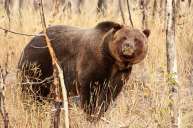Most people equate Yellowstone with active and abundant wildlife, including grizzly bears. So, it may be surprising to hear that Montana has announced plans to start trucking more bears into Yellowstone and the surrounding area.
This move isn't just to scare tourists: Officials hope that bringing new grizzlies in from the nearby Northern Continental Divide Ecosystem will boost the genetic diversity among the Greater Yellowstone Ecosystem bears.
You see, while grizzlies have made leaps and strides in increasing their population from roughly 700 in 1975 across the 48 contiguous states to a whopping near-2,000, our grizzly bear population now faces a new threat: a lack of genetic diversity.
Grizzly bears once spread across the Lower 48 with an estimated 50,000 in the U.S. prior to 1800. But by the mid-twentieth century, they were at serious risk of going extinct thanks to overhunting and habitat loss, and were officially added to the Endangered Species list. Biologists and government agencies have since spent decades on exhaustive reintroduction efforts to help grizzly populations rebound in specific "recovery zones"—namely Wyoming, Montana, Idaho, and Washington.
But when animals breed from the same genetic line, it becomes a issue. Genetic diversity is important to any animal species. Without varied genes, species are not able to respond to changing environments (e.g., deforestation, warming temperatures), a very real risk for any animal given the changing climate and increasing urbanization.
With recovering grizzly bear populations are already threatened by habitat loss and human conflict, Montana has hatched its ambitious plan to improve the genetic diversity of Yellowstone grizzlies and help the bears become more resilient.
The bear populations in the Greater Yellowstone Ecosystem (GYE) and the Northern Continental Divide Ecosystem (NCDE) aren't all that far from each other—the edges of the two ecosystems are only 35 miles apart. Despite that, a grizzly from the NCDE has never made the trip over to the GYE. Instead, they head north to Montana, leaving the GYE bears isolated.
Without this influx of new genes, Yellowstone bears are not only at risk of continuing to inbreed, but they also lack the genetic diversity needed to adapt well to a changing world. According to a 2022 case study published by the Conservation Genetics Resources, the GYE grizzlies don't have the genetic diversity needed to adapt to their changing environment long-term.
The hope is that inserting a better variety of genes will allow the still-officially-endangered bears to better cope with changing food sources and habitats.
Even worse, the GYE population growth has also been slowing since 2001, according to the Interagency Grizzly Bear Study Team (IGBST), a group of scientists responsible for long-term monitoring of the Yellowstone bears.
Montana's news comes at a time when states are attempting to remove Endangered Species protections from grizzly bears in the Lower 48, citing the growing populations as a sign of recovery. In fact, in the two instances grizzlies in the Yellowstone area have been up for delisting—once in 2007 and again in 2017—the federal judges specifically cited concerns over a lack of genetic diversity, among other things, in their denial.
A boost in not only genetic diversity but also sheer numbers of local populations able to mate would be especially important to help grizzlies jumpstart rebuilding their populations and in extending their ranges. Climate change and habitat loss aren't making it easy for bears to recover, even somewhere as remote as Yellowstone.
With this new plan to increase genetic diversity in GYE's grizzly bears, it is possible that the next attempt at delisting will be passed. The Montana Fish, Wildlife, and Parks has already added two employees to their roster to help with the grizzly relocation project, which is planned for next summer. Wildlife officials plan to move at least two female grizzlies from Montana into an as-yet unknown portion of the GYE. Every effort will be made to ensure that the grizzlies are conflict-free and have not been habituated to humans.
READ MORE: Why Are Wild Flamingos Flocking to Wisconsin, Ohio, and Other States?




